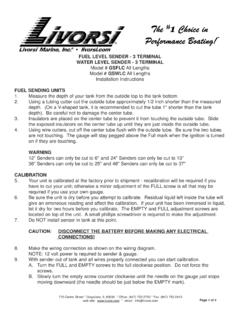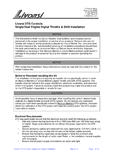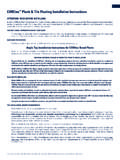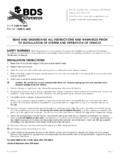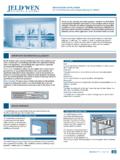Transcription of FLOWMETER INSTALLATION INSTRUCTIONS - Livorsi Marine
1 FLOWMETER INSTALLATION INSTRUCTIONS - 1 - Rev 1, 4/25/2005 SAFETY FIRST: Follow ALL safety precautions when working on motor equipment-wear safety glasses! Fuel vapors and liquid are extremely flammable and explosive, personal injury and/or property damage could occur. Complete all work in a well-ventilated area. ALWAYS disconnect (-) negative battery cable before any electrical work. SPECIFICATIONS: Models: 40 GPH & 80 GPH Analog Meter: Indicates Current Fuel Usage Digital Display: Indicates Fuel Rate, Total Fuel, & Trip Fuel Operating Voltage: 12 (10-16) Volt Negative Ground Supported Sensors: 231, 233, & 20 B Capabilities: 2 Engines with 2 Flow Sensors (feed & return) Per Engine Connections: Two 6-Pin Deutsch #DT06-6S 6-Wire Pigtail Harness Part #FFH Illumination: Red LED Mounting: Hole Max Panel Thickness: Operating Temp: -20 C +85 C Sealing: Fully Sealed to 5 psi Vibration: 10G, Random, 50-2000 Hz PRECAUTIONS.
2 This instrument should be installed by a competent Marine mechanic. Read ALL INSTRUCTIONS before installing instrument. FOR ACCURATE RESULTS, THIS UNIT MUST BE PROPERLY CALIBRATED. FLOWMETER MOUNTING: 1. Disconnect (-) negative battery cable. 2. Recommended panel hole size is or 3. Insert the instrument in the panel and place the U-Bracket over the mounting studs. 4. Install one washer & one nut on each stud over the U-Bracket. 5. Tighten the nuts (4 to 6 ) to secure the instrument. CAUTION: DO NOT OVER-TORQUE! FLOWMETER INSTALLATION INSTRUCTIONS - 2 - FLOWMETER WIRING CONNECTOR 1: Disconnect (-) negative battery cable before doing any electrical work.
3 Use 18-ga. or larger wire to make all electrical connections. 1. Connect the RED wire (pin 1) to a switched 12 volt source (properly fused). 2. Connect the ORANGE wire (pin 2) to the white wire of the PORT feed flow sensor. 3. Connect the BLUE wire (pin 3) to the 12 volt instrument lighting circuit. 4. Connect the WHITE wire (pin 4) to the white wire of the PORT return flow sensor. Only used with return style fuel systems. 5. Connect the GRAY wire (pin 5) to one terminal of a momentary contact push-button switch. Connect the other push-button terminal to an electrical ground. 6. Connect the BLACK wire (pin 6) to a secure electrical ground.
4 FLOWMETER WIRING CONNECTOR 2: NOTE: Connector 2 is only needed for dual engines. Disconnect (-) negative battery cable before doing any electrical work. Use 18-ga. or larger wire to make all electrical connections. 1. RED wire (pin 1) No connection. 2. Connect the ORANGE wire (pin 2) to the white wire of the STARBOARD return flow sensor. Only used with return style fuel systems. 3. BLUE wire (pin 3) No connection. 4. WHITE wire (pin 4) No connection. 5. Connect the GRAY wire (pin 5) to one terminal of a single-pole-single-throw switch. Connect the other switch terminal to an electrical ground. 6. Connect the BLACK wire (pin 6) to the white wire of the STARBOARD feed flow sensor.
5 7. After verifying all electrical connections, reconnect the (-) negative battery cable and check for proper operation and complete the calibration/set-up procedure. FLOWMETER INSTALLATION INSTRUCTIONS - 3 - GENERAL OPERATION: WARNING: The FLOWMETER must be properly set-up and calibrated before use. Failure to follow proper set-up and calibration procedures can cause erroneous readings. The analog pointer indicates actual fuel usage for the PORT or STARBOARD engines, depending on the PORT/STARBOARD select switch position. To switch between the PORT and STARBOARD engines, change the position of the PORT/STARBOARD select switch.
6 The digital display will indicate the total fuel consumed (gallons), trip fuel usage (gallons), and actual fuel usage (gallons/hour) for both PORT or STARBOARD engines, depending on the PORT/STARBOARD select switch position. To switch between the PORT and STARBOARD engines, Change the position of the PORT/STARBOARD select switch. PORT DISPLAY STARBOARD DISPLAY Tap the trip/reset button to scroll through the items on the digital display. While viewing any total or trip parameter, it can be reset by pressing & holding the trip/reset button for 5 seconds. Fuel flow sensor INSTALLATION INSTRUCTIONS This flow sensor must be mounted in a solid, secure, and horizontal location, as low in the entire fuel system as possible.
7 The fuel needs to exit the sensor and travel up-hill from the location that the sensor is mounted. The outlet should be at least 1 or 2 inches lower than the fuel pump inlet, priming bulb, or the pulsation dampener (if used for your application). Install the sensor(s) 12 upstream of the fuel pump, priming bulb, or the pulsation dampener to improve the system accuracy. The location to mount the sender is critical; take some time to find the best possible location. It needs to be solid; away from water, heat, any moving parts, and most importantly, safe. The model number 231 and 20 B gasoline sensors must be installed downstream of a fuel filter or water separator.
8 If your application is a carb-fed inboard or I/O engine using a diaphragm fuel pump, and is not listed below, you MAY need to use a gasoline pulsation dampener. If you experience severely inaccurate readings, your application MAY require a pulsation dampener. These are available for purchase through Livorsi Marine , and the model number is PD. **Important note the following applications DO NOT require a pulsation dampener** Outboard gasoline engines including Ficht, Optimax, 2 & 4-cycle. Closed loop EFI gasoline outboard, inboard, and I/O engines. Open return EFI gasoline inboard and I/O engines. Make sure that the location of the sensor to be mounted is a low or the lowest point of the fuel system, and that when the fuel exits the sensor it must travel up hill slightly.
9 One or two inches of vertical rise is adequate, and more is ok. The sensor MUST be protected by and installed downstream of a fuel filter or water separator. The sensor is tolerant of fine debris; however, a coarse screen (up to 800 microns) or a water separator is all that is required. FLOWMETER INSTALLATION INSTRUCTIONS - 4 - For the best possible operation, it is highly recommended that the sensor be installed between the fuel filter and the fuel pump inlet. There should be AT LEAST twelve inches of fuel hose (more is ok) between the sensor and the fuel pump inlet. If required, the pulsation dampener must be installed horizontally, with its orientation arrow pointing up.
10 When plumbing your sensor into your fuel system, plan carefully to minimize the number of 90 degree elbow fittings and pipe fittings. Excessive use may cause a high vacuum, fuel restricting pressure drop across the fuel system. If severe enough, engine damage may result. Whenever possible, use large radius hose bends instead of elbows. Small radius hose bends create twice as much pressure drop as a straight piece of hose does. If two pieces of hose are connected by a fitting, remove that portion and replace it with a single piece of hose cut to the correct length. Refer to your engine owner s manual for the maximum fuel pump vacuum. A vacuum gauge can be used to confirm that the system is within the manufacturer s limits.

